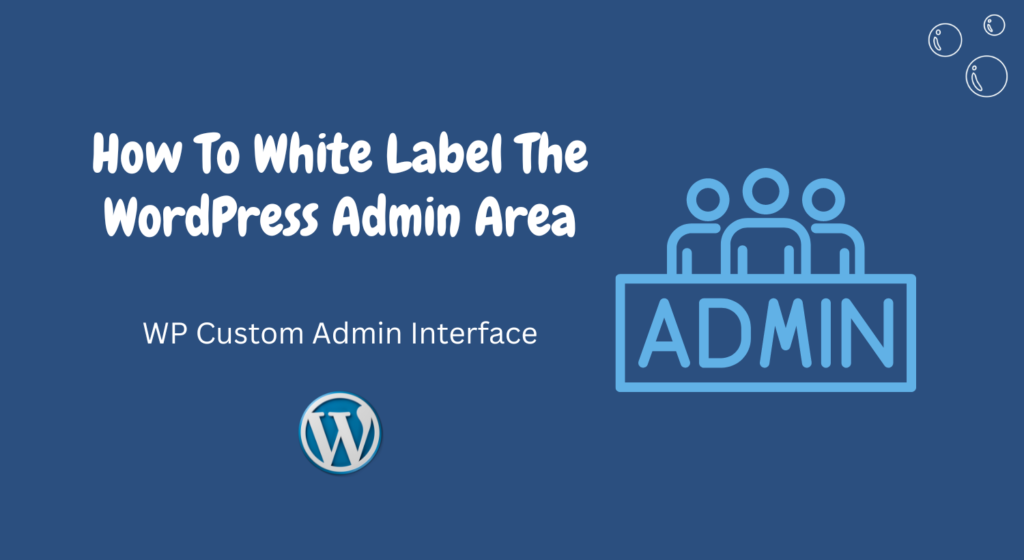In the digital realm, establishing a distinct brand identity is paramount for businesses.
This extends to all aspects of their online presence, including their WordPress website’s admin area.
White labeling the WordPress admin interface involves customizing it to reflect your brand’s identity, ensuring a seamless and cohesive user experience for administrators and clients alike.
Understanding the Importance of Customizing the Admin Interface
The default WordPress admin interface might not always align with your brand’s aesthetics or requirements.
By white labeling the admin area, you can create a professional and branded environment that enhances user experience and strengthens brand identity.
It allows you to tailor the interface to your specific needs, providing a personalized touch that resonates with your audience.
Choosing the Right White Labeling Solution
When it comes to white labeling the WordPress admin area, you have two primary options: using plugins or manual customization.
While plugins offer convenience and ease of use, manual customization provides greater flexibility and control over the process.
Consider your requirements and technical expertise before deciding on the most suitable approach for your website.
Steps to White Label the WordPress Admin Area
Installing and Activating a White Label Plugin
Begin by researching and selecting a reputable white-label plugin from the WordPress repository or third-party sources.
Install and activate the chosen plugin from the WordPress dashboard.
Once activated, navigate to the plugin settings to start customizing the admin interface according to your branding guidelines.
Customizing the Login Screen
The login screen serves as the gateway to your WordPress admin area and is often the first point of interaction for users.
Customize the login screen with your brand’s logo, colors, and background imagery to create a cohesive brand experience from the outset.
Personalizing the Dashboard
The WordPress dashboard is where administrators manage website content, settings, and updates.
Personalize the dashboard by rearranging widgets, adding custom widgets, and incorporating brand elements such as logos, colors, and typography.
This helps create a user-friendly environment that aligns with your brand’s identity.
Customizing the Admin Menu
The admin menu provides access to various WordPress features and functionalities.
Customize the admin menu by rearranging items, renaming labels, and adding custom links to streamline navigation and reflect your brand’s terminology.
Ensure consistency in branding across all menu elements for a cohesive user experience.
Branding Emails and Notifications
WordPress sends out various emails and notifications to users, such as password resets, new user registrations, and comment notifications.
Brand these communications by adding your logo, customizing email templates, and incorporating brand-specific messaging.
This reinforces brand recognition and professionalism in all interactions with users.
Best Practices for Effective White Labeling
Consistency in Branding
Maintain consistency in branding elements such as colors, logos, and typography throughout the white labeling process.
This fosters brand recognition and enhances user trust and loyalty.
User-Friendly Interface
Prioritize user experience by designing a user-friendly admin interface that is intuitive and easy to navigate.
Avoid clutter and complexity, opting for a clean and organized layout that promotes efficiency and productivity.
Security Considerations
Ensure that your white labeling efforts do not compromise the security of your WordPress website.
Choose reputable plugins and themes, keep all software updated, and implement robust security measures to safeguard against potential vulnerabilities.
Testing and Troubleshooting
Testing Across Devices and Browsers
Before deploying your white-labeled admin interface, thoroughly test it across different devices, screen sizes, and web browsers to ensure compatibility and responsiveness.
Address any discrepancies or layout issues to deliver a seamless user experience across all platforms.
Addressing Compatibility Issues
In some cases, white-labeling plugins or customizations may conflict with other plugins or themes, resulting in compatibility issues.
Troubleshoot any conflicts by deactivating plugins or reverting customizations until the issue is resolved.
Consult with a developer if necessary to ensure smooth integration and functionality.
Conclusion
White labeling the WordPress admin area offers businesses the opportunity to create a branded and professional environment that enhances user experience and strengthens brand identity.
By following best practices and leveraging the right tools, you can customize every aspect of the admin interface to align with your brand’s aesthetics and requirements.
Read this article to take a backup of your WordPress website: UpdraftPlus WordPress Backup Plugin Tutorial 2024
FAQs
Is white labeling the WordPress admin area complicated?
White labeling can be straightforward with the right tools and guidance. Using reputable plugins or seeking assistance from experienced developers can simplify the process.
Can I revert white labeling customizations if needed?
Yes, most white-labeling plugins allow you to revert customizations or deactivate them altogether if necessary. However, it’s essential to back up your website before making significant changes.
Are there any security risks associated with white labeling?
While white labeling itself doesn’t pose security risks, using unreliable plugins or neglecting security measures can expose your website to vulnerabilities. It’s crucial to prioritize security throughout the white labeling process.
Can I customize the admin interface without using plugins?
Yes, manual customization of the admin interface is possible by editing WordPress files and adding custom code. However, this approach requires technical expertise and may be more time-consuming than using plugins.
Is white labeling only beneficial for businesses?
No, white labeling can benefit any WordPress website owner looking to establish a distinct brand identity and provide a cohesive user experience. Whether you’re a business, blogger, or nonprofit organization, customizing the admin interface can enhance your online presence.


